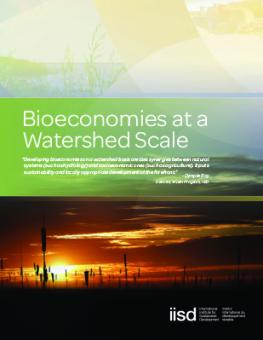
Bioeconomies at a Watershed Scale (brochure)
This brochure provides an overview of IISD’s watershed-focused approach to the bioeconomy.
To do so, it details two case studies of watershed-based bioeconomies in: 1) the Lake Winnipeg watershed (Canada) and; 2) Wuliangsuhai Lake (China). In recent years, the idea of the bioeconomy has taken root in government policy and business development. IISD applies the bioeconomy concept at the watershed scale, using plant materials that are either naturally occurring (e.g., wetland plants) or are by-products of existing activities (e.g., agricultural crop residues) to help create such end-products as bioenergy (e.g., pellets, cubes, biomethane, syngas, ethanol, biocoal), biochar, solid and liquid fertilizers, biocomposites and building materials. IISD’s work in this area looks not only at the tangible end-products of the bioeconomy, but also values other benefits that can be gained from developing bioeconomies on a watershed basis. These include: water quality improvements; nutrient capture to prevent algal blooms; carbon credits; methane credits; habitat improvement; flood and drought protection; and strengthening rural economies.
Participating experts
You might also be interested in
Large Area Planning in the Nelson-Churchill River Basin (NCRB): Laying a foundation in northern Manitoba
This report explores two trends—the growing tendency towards large basin management and consideration of ecosystem services in decision making—for the northern portion of the Nelson-Churchill River Basin in Canada.
Large Area Planning in the Nelson-Churchill River Basin (NCRB): Laying a foundation in northern Manitoba (Summary)
This document summarizes a longer report that explores two trends—the growing tendency towards large basin management and consideration of ecosystem services in decision making—for the northern portion of the Nelson-Churchill River Basin in Canada.